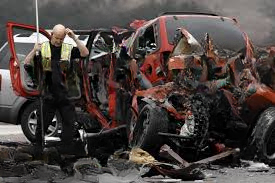
It began with a quiet tension—a subtle unease that seemed to hang in the air. Residents described an odd stillness, a feeling that something was off long before tragedy struck. Streetlights flickered erratically, minor tremors rattled the ground, and an inexplicable sense of dread lingered. In retrospect, these signals appear as warnings that, perhaps, were overlooked or underestimated.
Yet within moments, the calm turned into chaos. What had begun as a seemingly ordinary day erupted into a catastrophe that would claim more than 65 lives, leaving families shattered and communities struggling to comprehend the sudden horror.
A Day of Unimaginable Tragedy
The morning started like any other. People went about their routines, children played, and families prepared for the day ahead. But disaster struck with a sudden, devastating force. Those present describe the scene as surreal—a blur of noise, dust, and destruction. First responders, recounting their experiences, called it “absolute chaos.”
Buildings that had seemed stable moments before crumbled. Metal structures bent, concrete collapsed, and debris littered the area in every direction. The screams of people trapped beneath rubble echoed for what felt like an eternity. From the youngest children to the oldest members of the community, no one was spared from the merciless sweep of the disaster.
Survivors, many of whom narrowly escaped with their lives, recall the terrifying speed of events. One eyewitness recounted, “We heard a loud crack, and then the entire structure gave way. There was no time to react. People were screaming, running, trying to help each other, but it all happened so fast.”
Emergency crews arrived swiftly, but the scale of the tragedy was overwhelming. Rescue teams worked tirelessly through the night, navigating dangerous debris and unstable terrain. The emotional toll on rescuers was immense, as they pulled survivors from wreckage and, tragically, recovered bodies of those who could not be saved.
Signs That Were Missed
Now, investigators are piecing together the chain of events that led to such devastation. Preliminary findings suggest a mix of mechanical failure, structural weakness, and potentially overlooked maintenance issues. In the days before the disaster, several alerts and minor incidents were reportedly ignored. Local residents had noticed unusual occurrences, such as vibrations in nearby structures, erratic equipment behavior, and other warning signs that, in hindsight, pointed to imminent danger.
Experts are emphasizing that the tragedy may not have been entirely unpredictable. Many of the systems in place to ensure safety failed—either through neglect, oversight, or underestimation of risk. Structural engineers, safety analysts, and community advocates are all contributing to an ongoing investigation, seeking to uncover what could have prevented this catastrophic outcome.
Officials have pledged transparency and accountability. “We owe it to the families and to the community to determine exactly what happened,” one spokesperson stated. “If negligence played a role, those responsible will face the consequences. This must never happen again.”
The Human Cost
While investigations continue, the human impact is undeniable. Entire families were lost in moments, leaving a void that cannot be filled. Survivors carry not only physical injuries but also deep psychological scars. The trauma of witnessing such a sudden and violent loss weighs heavily, and many report nightmares, anxiety, and an overwhelming sense of vulnerability.
Communities are coming together to support one another, offering aid, shelter, and emotional care. Local organizations have set up counseling services for survivors and families, emphasizing that healing will be a long process. While physical reconstruction may begin relatively quickly, the emotional rebuilding will take years—if not decades.
This tragedy is also sparking wider reflection. Residents and leaders are asking difficult questions about safety standards, accountability, and the systems designed to protect the public. How many other risks are overlooked? How can communities prevent similar disasters in the future? These questions are now at the forefront of the conversation.
Beyond Headlines: A Call for Change
This is not merely a story about destruction; it is a call to action. Systems intended to protect lives failed, and the results were catastrophic. Whether through inattention, miscommunication, or systemic flaws, the breakdown had devastating consequences.
Experts emphasize that disasters like this highlight the need for proactive safety measures. Regular maintenance, adherence to protocols, and responsiveness to warning signs are crucial. Authorities are now reviewing policies, implementing new inspection regimes, and ensuring that the public is better protected moving forward.
Communities around the world are taking note. From city planners to emergency response teams, the lessons learned here are being applied elsewhere. The tragedy serves as a stark reminder: even minor warnings should never be ignored. The price of oversight can be catastrophic.
The Importance of Vigilance
This event also underscores the role of public awareness. Citizens play a critical role in safety by reporting anomalies, unusual vibrations, or irregularities in equipment and infrastructure. Communities must foster a culture of vigilance, where small concerns are treated seriously. In many cases, timely reporting and proactive responses can prevent the escalation of risk into disaster.
Safety, experts note, cannot simply be a slogan—it must be a commitment. From engineering standards to emergency preparedness plans, the focus must always be on preventing loss, not simply reacting after it occurs. The lessons of this tragedy are clear: respect for systems, attention to detail, and a commitment to vigilance save lives.
Honoring Those Lost
More than 65 lives were lost in an instant. Each story represents a person with hopes, dreams, and loved ones. Families grieve, communities mourn, and a nation reflects on the fragility of life. Yet, even in sorrow, there is a growing determination to ensure that such a tragedy is never repeated.
Memorials are being planned, and initiatives to improve safety are underway. Local governments, advocacy groups, and citizen organizations are collaborating to make tangible changes. The memory of those lost is becoming a catalyst for reform—turning grief into a force for prevention and protection.
Final Reflections
This disaster is a sobering reminder of life’s unpredictability and the importance of paying attention to warning signs, no matter how small they may seem. Silence, subtle tremors, and minor irregularities should never be dismissed.
While the tragedy has left deep scars, it also provides an opportunity for communities to come together, implement meaningful reforms, and strengthen systems designed to protect lives. Safety is not optional; it is a responsibility shared by individuals, organizations, and governments alike.
By learning from events like this, we can honor those who were lost—not just in words, but through concrete actions that prevent future disasters. The promise of safety must become a reality, ensuring that adventure, work, and daily life can continue without fear.
From the quiet whispers before the catastrophe to the chaos that followed, the lesson is clear: vigilance, accountability, and respect for warning signs are essential. The lives lost must not be forgotten, and the world must listen to its subtle signals before it’s too late.




